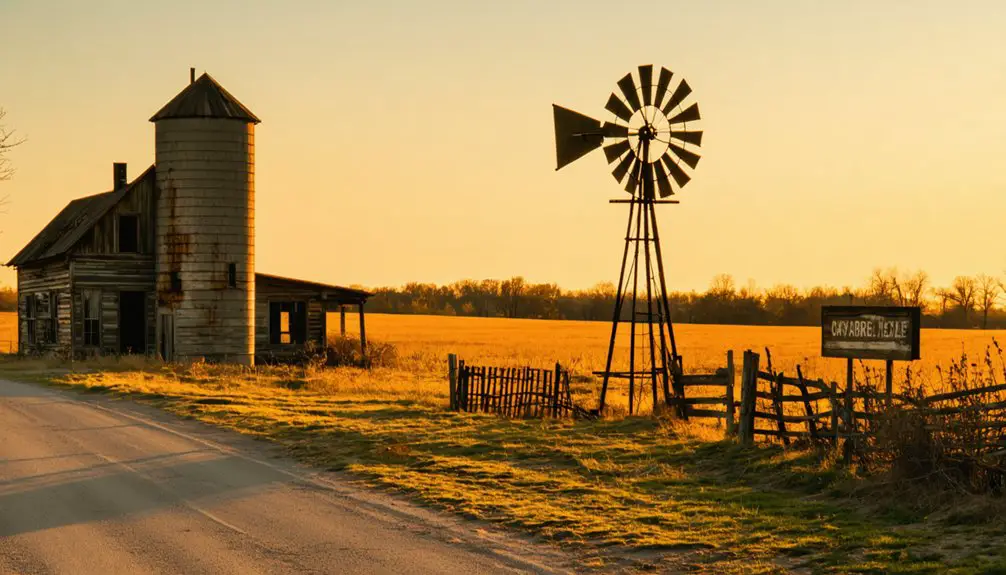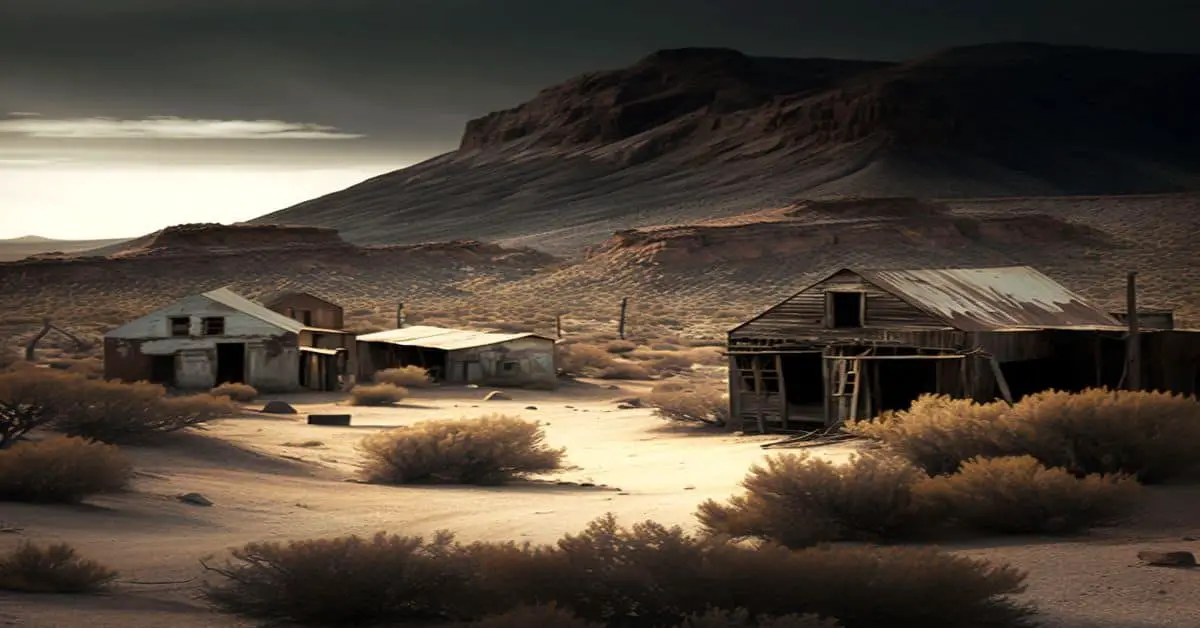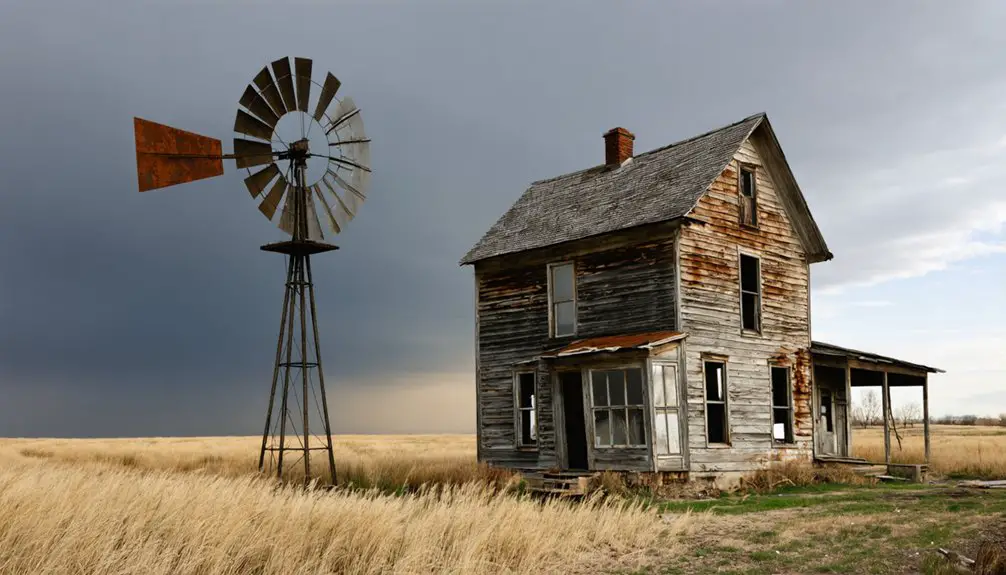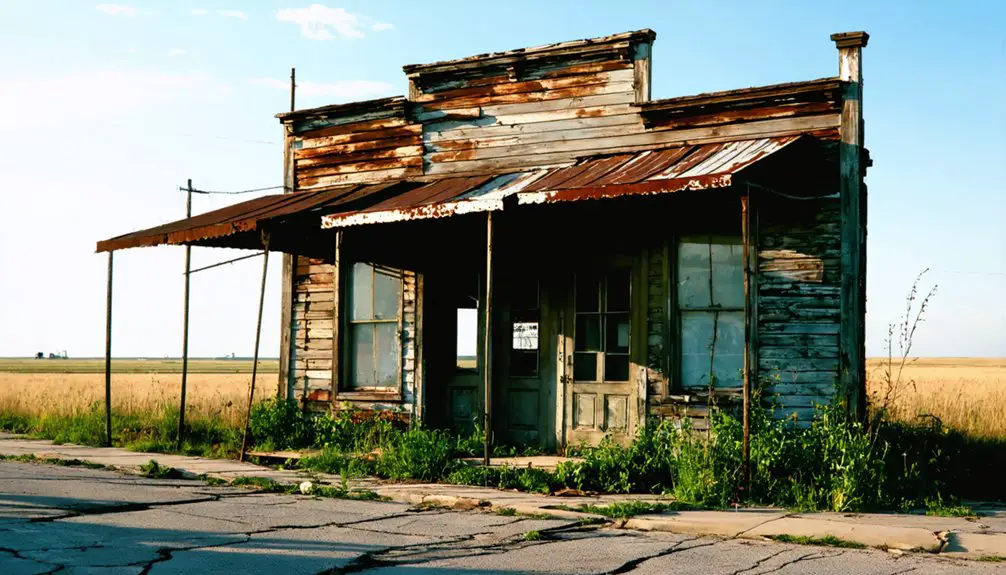You’ll find North Summerfield, established in the 1880s, along Nebraska’s historic railroad lines. This once-thriving agricultural community handled 200,000 bushels of grain through its elevators and peaked around 1910 with 554 residents. The Missouri Pacific Railroad‘s arrival in 1889 boosted local commerce, while Holy Family Catholic Church served as the social hub. Though abandoned as railroad traffic declined, the town’s preserved structures and vintage retail spaces now tell a rich pioneer story.
Key Takeaways
- North Summerfield was established in the 1880s along Nebraska’s railroad lines, peaking with 554 residents around 1910.
- The town’s economy centered on grain storage and agricultural services, handling 200,000 bushels through its elevators.
- Declining railroad traffic and loss of essential services led to population decline and eventual abandonment.
- Historical structures are being preserved through adaptive reuse projects, converting buildings into vintage retail spaces and Airbnb venues.
- The town’s preservation efforts focus on maintaining cultural landmarks while creating new economic opportunities through tourism.
Early Settlement and Origins
When the railroads expanded across Nebraska in the 1880s, North Summerfield emerged as one of many small towns established along the branch rail lines.
You’ll find its origins closely tied to railroad expansion, which shaped settlement patterns throughout the region by determining where communities would thrive.
Named similarly to its Kansas counterpart, North Summerfield quickly developed into a crucial trade point for local farmers. The town initially handled 200,000 bushels of grain through its elevators.
As a vital trading hub for area farmers, North Summerfield mirrored its Kansas namesake while serving the region’s agricultural commerce.
The town’s strategic location near the Kansas-Nebraska border gave residents access to multiple markets and trading centers.
You’ll recognize familiar elements of railroad town development – grain elevators, general stores, and institutions like schools and churches sprung up to serve the growing farming community.
The town’s prosperity depended heavily on its rail connections, which enabled agricultural exports and community growth. Similar to Amboy Mill’s operation, North Summerfield’s grain processing facilities were vital to the local economy.
Life in North Summerfield’s Heyday
If you’d visited North Summerfield during its peak, you’d have found a bustling community of roughly 100 residents going about their daily routines of farming, trading at the local general store, and conducting business at the bank.
The town’s small business district served as the heart of commerce, where merchants offered essential supplies, hardware, and drugstore items to both townspeople and surrounding farm families. The strategic location near river trade routes made the town an important stop for goods and travelers. Local farmers cultivated vast fields of corn and soybeans that sustained the agricultural economy.
Community life centered around church gatherings, school events, and social activities in the public parks, creating strong bonds among the tight-knit population.
Daily Pioneer Activities
Life in North Summerfield revolved around three primary spheres of daily activity: agricultural work, religious observance, and community engagement.
You’d find pioneer chores dominated by the seasonal rhythms of planting and harvesting. Working the fields with horse-drawn plows, you’d cultivate staple crops like corn and wheat, while tending to livestock that complemented your farm operations.
When harvest time came, you’d coordinate with neighbors to bring your grain to the local elevators, which could store hundreds of thousands of bushels.
Daily life wasn’t all work, though. You’d attend services at Holy Family Catholic Church, where your family would gather for both worship and social events. Much like the town of Monowi’s sole resident, the community relied on each person playing multiple roles to keep things running.
Children would split their time between schoolhouse lessons and helping with farm duties, while community gatherings kept everyone connected through shared work and celebration.
Small Business District
Beyond the daily rhythms of farm work and church gatherings, North Summerfield’s business district formed the bustling heart of pioneer commerce. You’d find a diverse ecosystem of enterprises that sprang up following the 1888 townsite founding, from Heard & McGinty’s first store to an array of specialty shops.
Like many frontier towns serving as open-air markets for farmers and travelers, North Summerfield’s district evolved to meet expanding needs. The district’s business evolution reflected the town’s growing independence, with merchants offering everything from dry goods to professional services. Similar to how Hicks Retinning represented small industry growth in the region from the 1870s to 1970s, local enterprises adapted to serve evolving community needs.
You could’ve witnessed the transformative impact of the Missouri Pacific Railroad’s arrival in 1889, which supercharged local commerce by connecting the town to broader markets.
The district’s community dynamics centered around multi-purpose buildings that adapted over time, housing various businesses from shoe companies to motor dealerships, while sustaining North Summerfield’s economic significance through the early 20th century.
Community Social Gatherings
During North Summerfield’s peak years around 1910, the town’s 554 residents wove a rich social tapestry through diverse community gatherings.
You’d find locals congregating at Holy Family Catholic Church, established in 1892, for both religious services and community festivals.
Social traditions centered around three primary venues:
- The local schools, which hosted town meetings and civic events
- Community parks, where seasonal agricultural fairs and picnics took place
- Social halls, where dances and musical performances entertained townsfolk
Railroad connections enabled residents to maintain social ties with neighboring communities, while the town’s 50 automobiles facilitated regional visits.
Street corners and the railroad depot served as informal meeting spots where you’d catch the latest news and gossip, reflecting the close-knit nature of rural Nebraska life.
Like many railroad towns of the era, the community’s social activities thrived until transportation patterns changed.
Like the residents of Youghiogheny Lake, this vibrant social life would eventually come to an end when the town was abandoned.
Economic Activities and Local Commerce
You’d find North Summerfield’s economic heart in its bustling grain elevators, which by 1916 handled around 200,000 bushels and connected local farmers to wider markets through the Missouri Pacific Railroad.
The town’s commercial district featured approximately 40 thriving businesses, including general stores and banks with deposits reaching $250,000, ranking third among 27 county banks.
The railroad’s presence strengthened North Summerfield’s position as a regional trade hub, enabling efficient transport of agricultural products and supporting a network of telegraph and express offices that facilitated business communications.
Agricultural Trade and Services
While North Summerfield’s agricultural economy centered on crop production, its commercial landscape featured a diverse network of support services and trade activities. The area’s establishment as a vital trade junction in 1769 helped shape its agricultural development.
You’d find a robust integration of crop diversification and livestock operations, with farmers adapting their production to meet local market demands rather than distant shipping costs.
The town’s agricultural services included:
- Farm supply stores providing seeds, feed, and equipment
- Local mechanics and maintenance services for farm machinery
- Agricultural education and training programs
You could witness the practical approach of farmers who turned to mixed farming methods, using corn and wheat primarily for livestock feed rather than cash crops.
This strategy helped overcome market challenges while supporting a network of local businesses that provided essential services to the farming community.
Banking and General Stores
Two essential institutions anchored North Summerfield’s commercial landscape: banks and general stores.
Banking trends reflected the town’s growing prosperity, with financial services expanding alongside telegraph and express offices by 1910. You’d find advanced capabilities like international money orders supporting the region’s economic freedom and trade relationships.
Store evolution shaped North Summerfield’s development, with multiple general merchandise stores forming the backbone of local commerce.
Before the devastating 1894 fire, you could visit diverse retail establishments including drug stores, hardware stores, and variety shops. These businesses weren’t just retail outlets – they served as crucial hubs where farmers and residents could access provisions, exchange information, and conduct various transactions.
After the fire, merchants rebuilt with more substantial structures, demonstrating the community’s resilience and commitment to stronger commercial infrastructure.
Railroad Business Connections
The growth of North Summerfield’s financial and retail sectors paralleled the expansion of its railroad connections, which transformed the town’s economic landscape after 1869.
You would’ve seen significant changes as railroad infrastructure integrated the town into regional trade networks, connecting it to major markets across Nebraska and beyond.
The railroad’s impact on North Summerfield’s commerce manifested in several key ways:
- New business opportunities emerged in freight handling, warehousing, and supply depot operations.
- Local entrepreneurs and businessmen invested directly in railroad ventures, strengthening community ties.
- Agricultural exports increased as farmers gained efficient access to broader markets.
The town’s strategic position along the rail line attracted townsite developers who recognized the potential for commercial growth, leading to increased land values and business development opportunities through the 1870s and 1880s.
Transportation Routes and Accessibility
Like many early Nebraska settlements, North Summerfield’s development was inextricably linked to railroad transportation networks that shaped its accessibility and eventual decline.
You’ll find that the town’s transportation evolution mirrors the common pattern of railroad-dependent communities across Nebraska, where initial rail access determined growth potential and sustainability.
Today, you can reach what remains of North Summerfield via county roads, though accessibility changes have left the site more isolated than in its heyday.
The original railroad tracks may still be visible, offering clues to historic transportation routes, while modern GPS mightn’t fully capture the pathways to the site.
Weather conditions can affect access, particularly during Nebraska’s challenging seasons, and you’ll need to navigate primarily unpaved routes that have replaced the once-vital rail connections.
Notable Buildings and Landmarks
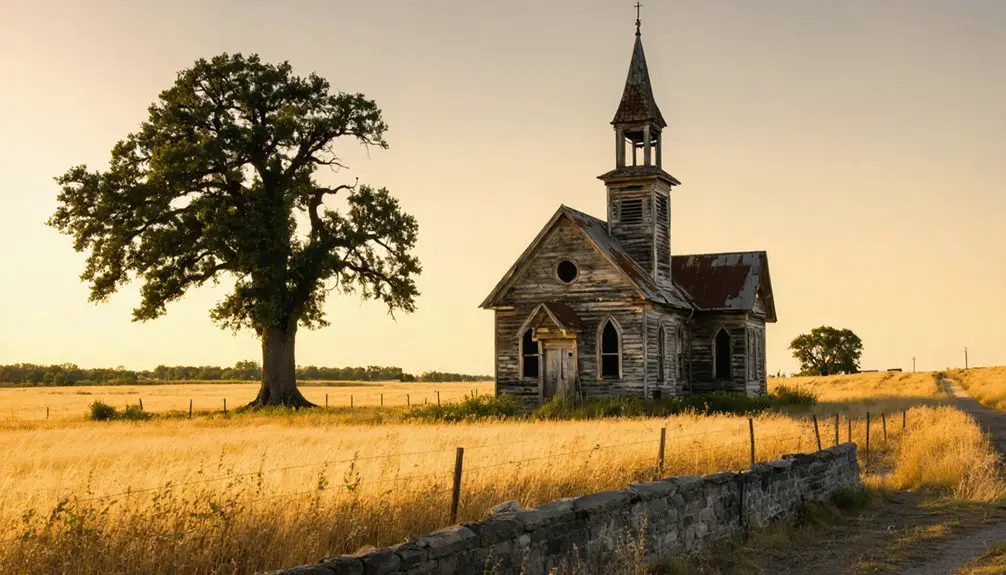
Stepping beyond the old transportation routes, North Summerfield’s architectural legacy stands preserved in its remaining structures and ruins.
You’ll find historic structures that tell the story of a once-thriving community identity, from the early 20th-century gas station to the limestone bar that served as a social hub.
The town’s cultural heart reveals itself through:
- Venus Church, standing quarter-mile from town center
- A former movie theater with its adjacent ladies’ lounge
- The old coffee shop, converted from another gas station
These buildings showcase the evolution of North Summerfield’s commercial and social life.
While many structures now crumble, including former general stores and residences, they’re silent witnesses to the town’s vibrant past, when Fourth of July celebrations drew crowds and the Warren Lake Monster captured local imagination.
Factors Leading to Abandonment
During North Summerfield’s decline in the early-to-mid 20th century, multiple factors converged to seal the town’s fate. Economic challenges hit hard as railroad traffic diminished, leading to reduced trade and fewer passenger stops.
The loss of essential services like schools, banks, and postal facilities made life increasingly difficult for remaining residents.
Environmental impacts also played a significant role in the town’s abandonment. The harsh climate affected agricultural productivity, while severe weather events in the region during the 1950s, including devastating tornadoes, prompted many families to relocate.
You’ll find that younger generations, seeking better employment opportunities, moved to growing urban centers. This exodus created a downward spiral – as population declined, infrastructure investment decreased, making the town less attractive to potential newcomers and accelerating its abandonment.
Archaeological Findings and Remnants
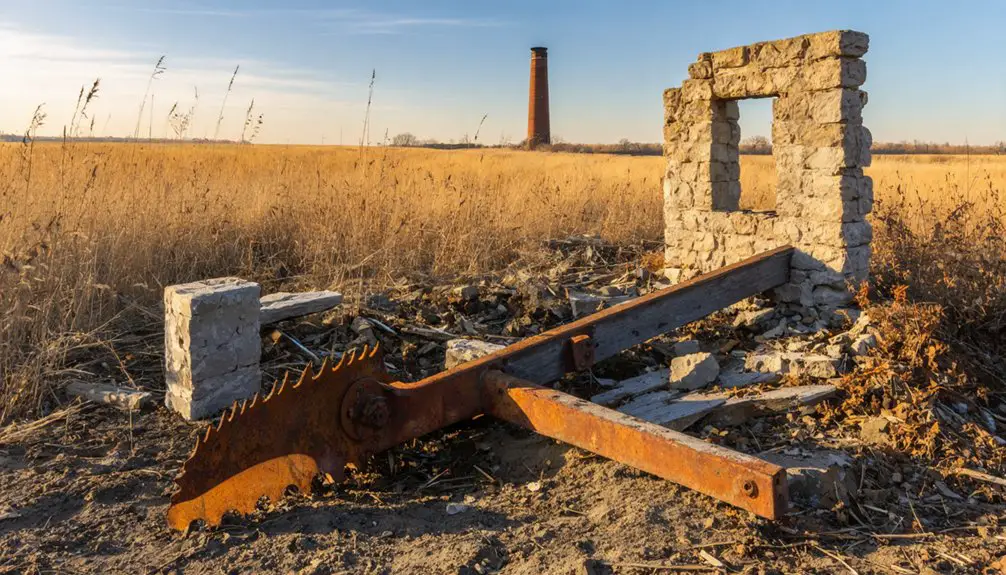
While archaeological investigations at North Summerfield have been limited, the ghost town’s physical remnants provide valuable insights into Nebraska’s settlement history.
You’ll find foundations and scattered building materials that hint at early settler life, while the surrounding archaeological context reveals broader regional patterns.
The area’s cultural deposits include:
Cultural evidence from North Summerfield’s past lies embedded in earthen layers, preserving a treasure trove of settlement artifacts.
- Clay and stone figurines discovered in nearby Sandhills regions
- Large flat-bottom pots crafted from local siltstone
- Trade items indicating regional exchange networks
Buried beneath sandy loam layers, multiple soil horizons suggest occupation phases lasting 100-300 years.
Through GIS and predictive modeling, archaeologists have identified promising sites for future excavation.
The ghost town’s artifacts remain protected within stratified soil layers, preserving essential evidence of Nebraska’s past settlement patterns.
Historical Significance in Nebraska
As Nebraska’s railroad expansion shaped the Great Plains landscape in the late 19th century, North Summerfield emerged as a quintessential example of boom-and-bust settlement patterns.
You’ll find this town’s story reflecting broader cultural heritage themes of pioneer life, where grain elevators and general stores once buzzed with activity along essential rail lines.
The town’s trajectory mirrors the agricultural decline that transformed Nebraska’s countryside in the early 20th century.
When automobiles replaced trains and farmers began trading in larger markets, North Summerfield’s importance diminished.
Like many similar communities, it couldn’t adapt to the changing economic landscape.
Today, the ghost town serves as a powerful reminder of how transportation and agricultural shifts reshaped the Great Plains, making it a valuable case study in Nebraska’s settlement history.
Preservation Efforts and Legacy
Recent preservation initiatives have breathed new life into North Summerfield’s historic landscape. Through carefully planned preservation strategies, new property owners are transforming vacant buildings into vintage retail spaces and Airbnb venues, ensuring the town’s community heritage lives on.
You’ll find local authorities actively monitoring restoration progress, working with stakeholders to protect these cultural landmarks.
Key preservation approaches include:
- 365-day managed restoration timelines to prevent unnecessary demolition
- Adaptive reuse projects that balance historical authenticity with modern needs
- Collaboration between heirs, property owners, and city councils
You’re witnessing a sustainable model of ghost town preservation, where oral histories and physical structures connect current generations to their roots.
This blend of tourism, education, and cultural preservation creates a viable path forward for North Summerfield’s legacy.
Frequently Asked Questions
Were Any Famous Individuals or Historical Figures Associated With North Summerfield?
Like footprints in sand, famous residents left few traces here. You’ll find only two historical connections: Elias Summerfield as railroad superintendent and R.G. Cunningham as the first elected mayor.
What Natural Disasters, if Any, Affected North Summerfield’s Development?
You won’t find major natural disaster records – there’s no documented flood damage or drought impact that directly contributed to the town’s decline, though the region faced typical Great Plains weather challenges.
Did North Summerfield Have Any Unique Local Traditions or Celebrations?
You’d find both quiet gatherings and vibrant local festivals in this small community, with church celebrations, harvest events, and railroad-linked traditions defining their social calendar until the town’s gradual decline.
Were There Any Documented Crimes or Notable Incidents in North Summerfield?
You won’t find documented crimes or unsolved mysteries in the records – the town’s swift decline and minimal population left little trace of incidents beyond local folklore about economic hardships.
Did Native American Tribes Have Significant Interactions With North Summerfield Settlers?
You’ll find limited evidence of trade relations or cultural exchanges between settlers and Native tribes, though Omaha, Ponca, and Otoe peoples historically inhabited the region before white settlement forced their displacement.
References
- https://legendsofkansas.com/summerfield-kansas/
- https://www.youtube.com/watch?v=redtU6GT-BY
- https://summerfieldgoods.com/blogs/our-blog/tales-from-summerfield-kansas
- https://history.nebraska.gov/wp-content/uploads/2017/12/doc_publications_NH1962GhostCounties.pdf
- https://en.wikipedia.org/wiki/List_of_ghost_towns_in_Nebraska
- https://history.nebraska.gov/wp-content/uploads/2017/10/doc_publications_NH1973Bookwalter.pdf
- https://visitnebraska.com/trip-idea/explore-7-authentic-ghost-towns-nebraska
- https://freepages.history.rootsweb.com/~gtusa/usa/ne/sarpy-co.htm
- https://history.nebraska.gov/wp-content/uploads/2017/12/doc_publications_NH1937GhostTowns.pdf
- https://auburn.ne.gov/historic-district-properties/
